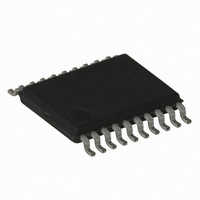ATTINY167-15XD Atmel, ATTINY167-15XD Datasheet - Page 169

ATTINY167-15XD
Manufacturer Part Number
ATTINY167-15XD
Description
MCU AVR 16K FLASH 15MHZ 20-TSSOP
Manufacturer
Atmel
Series
AVR® ATtinyr
Datasheet
1.ATTINY167-15MD.pdf
(283 pages)
Specifications of ATTINY167-15XD
Core Processor
AVR
Core Size
8-Bit
Speed
16MHz
Connectivity
I²C, LIN, SPI, UART/USART, USI
Peripherals
Brown-out Detect/Reset, POR, PWM, Temp Sensor, WDT
Number Of I /o
16
Program Memory Size
16KB (8K x 16)
Program Memory Type
FLASH
Eeprom Size
512 x 8
Ram Size
512 x 8
Voltage - Supply (vcc/vdd)
2.7 V ~ 5.5 V
Data Converters
A/D 11x10b
Oscillator Type
Internal
Operating Temperature
-40°C ~ 150°C
Package / Case
20-TSSOP
Processor Series
ATTINY1x
Core
AVR8
Data Bus Width
8 bit
Data Ram Size
512 B
Maximum Clock Frequency
16 MHz
Maximum Operating Temperature
+ 85 C
Mounting Style
SMD/SMT
3rd Party Development Tools
EWAVR, EWAVR-BL
Development Tools By Supplier
ATAVRDRAGON, ATSTK500, ATSTK600, ATAVRISP2, ATAVRONEKIT
Minimum Operating Temperature
- 40 C
For Use With
ATSTK600-SOIC - STK600 SOCKET/ADAPTER FOR SOIC
Lead Free Status / RoHS Status
Lead free / RoHS Compliant
- Current page: 169 of 283
- Download datasheet (5Mb)
15.4.6.4
15.4.7
15.4.7.1
15.4.7.2
15.4.7.3
7728G–AVR–06/10
UART Commands
Handling Data of LIN response
Data Handling
Rx Service
Tx Service
A FIFO data buffer is used for data of the LIN response. After setting all parameters in the LIN-
SEL register, repeated accesses to the LINDAT register perform data read or data write (c.f.
“Data Management” on page
Note that LRXDL[3..0] and LTXDL[3..0] are not linked to the data access.
Setting the LCMD[2] bit in LINENR register enables UART commands.
Tx Byte and Rx Byte services are independent as shown in
This combination of services is controlled by the LCMD[1..0] bits of LINENR register (c.f.
ure 15-5 on page
The FIFO used for LIN communication is disabled during UART accesses. LRXDL[3..0] and
LTXDL[3..0] values of LINDLR register are then irrelevant. LINDAT register is then used as
data register and LINSEL register is not relevant.
Once this service is enabled, the user is warned of an in-coming character by the LRXOK flag
of LINSIR register. Reading LINDAT register automatically clears the flag and makes free the
second stage of the buffer. If the user considers that the in-coming character is irrelevant with-
out reading it, he directly can clear the flag (see specific flag management described in
Section 15.6.2 on page
The intrinsic structure of the Rx service offers a 2-byte buffer. The fist one is used for serial to
parallel conversion, the second one receives the result of the conversion. This second buffer
byte is reached reading LINDAT register. If the 2-byte buffer is full, a new in-coming character
will overwrite the second one already recorded. An OVRERR error in LINERR register will
then accompany this character when read.
A FERR error in LINERR register will be set in case of framing error.
If this service is enabled, the user sends a character by writing in LINDAT register. Automati-
cally the LTXOK flag of LINSIR register is cleared. It will rise at the end of the serial
transmission. If no new character has to be sent, LTXOK flag can be cleared separately (see
specific flag management described in
There is no transmit buffering.
No error is detected by this service.
• Byte Transfer: the UART is selected but both Rx and Tx services are disabled,
• Rx Byte: only the Rx service is enable but Tx service is disabled,
• Tx Byte: only the Tx service is enable but Rx service is disabled,
• Full Duplex: the UART is selected and both Rx and Tx services are enabled.
166).
182).
179).
Section 15.6.2 on page
ATtiny87/ATtiny167
Table 15-1 on page
182).
167.
Fig-
169
Related parts for ATTINY167-15XD
Image
Part Number
Description
Manufacturer
Datasheet
Request
R

Part Number:
Description:
Manufacturer:
Atmel Corporation
Datasheet:

Part Number:
Description:
Manufacturer:
Atmel Corporation
Datasheet:

Part Number:
Description:
MCU AVR 16K FLASH 15MHZ 32-QFN
Manufacturer:
Atmel
Datasheet:

Part Number:
Description:
IC MCU AVR 16K FLASH 20TSSOP
Manufacturer:
Atmel
Datasheet:

Part Number:
Description:
MCU AVR 16K FLASH 15MHZ 32-QFN
Manufacturer:
Atmel
Datasheet:

Part Number:
Description:
MCU AVR 16K FLASH 15MHZ 20-SOIC
Manufacturer:
Atmel
Datasheet:

Part Number:
Description:
MCU AVR 16K FLASH 15MHZ 20-TSSOP
Manufacturer:
Atmel
Datasheet:

Part Number:
Description:
IC MCU AVR 16K FLASH 20SOIC
Manufacturer:
Atmel
Datasheet:










